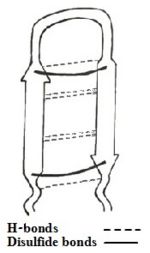Tachyplesin
From Proteopedia
(Difference between revisions)
| Line 65: | Line 65: | ||
[http://en.wikipedia.org/wiki/Escherichia_coli <i>Escherichia coli</i>] and [http://en.wikipedia.org/wiki/Staphylococcus_aureus <i>Listeria monocytogenes</i>] are Gram-negative and Gram-positive bacteria, respectively. They are the most common intestinal tract pathogenic bacteria in animals and humans. | [http://en.wikipedia.org/wiki/Escherichia_coli <i>Escherichia coli</i>] and [http://en.wikipedia.org/wiki/Staphylococcus_aureus <i>Listeria monocytogenes</i>] are Gram-negative and Gram-positive bacteria, respectively. They are the most common intestinal tract pathogenic bacteria in animals and humans. | ||
| + | Studying the effect of TP-I on <i>E. coli</i> and <i>S. aureus</i> will be valuable in guiding clinical practice. | ||
| + | The potential mechanism of E. coli membrane disruption by YP-I is the induction of macromolecule leakage into the cytoplasm and the release of potassium ions, leading to an increase in inner permeability, the formation of a toroidal pore, the neutralization of LPS, and the disruption of the permeability barrier of the outer membrane. TP-I killed E. coli mainly through cell membrane damage and intracellular esterase inactivation dependent on concentration. | ||
| + | In food production, requirements must be met for producing high quality food with minimal microbial contamination, and the determination of microbial viability based on different physiological and metabolic parameters is critical for acceptable sterilization. Therefore, the presence of injured, metabolically active bacteria is a very important aspect to consider in food production and for clinical applications. Sublethally injured cells might be repaired under suitable conditions. If TP-I is applied as a clinical treatment at a lower concentration than the MIC over a long period of time, drug resistance could develop.<ref name=Hong>Hong, Jun, et al. "Mechanism of tachyplesin I injury to bacterial membranes and intracellular enzymes, determined by laser confocal scanning microscopy and flow cytometry." Microbiological research (2014).</ref> | ||
== Possible Function as anti-tumor peptide == | == Possible Function as anti-tumor peptide == | ||
Revision as of 08:33, 7 January 2015
Introduction
| |||||||||||
References
- ↑ 1.0 1.1 1.2 Laederach A, Andreotti AH, Fulton DB. Solution and micelle-bound structures of tachyplesin I and its active aromatic linear derivatives. Biochemistry. 2002 Oct 15;41(41):12359-68. PMID:12369825
- ↑ 2.0 2.1 Chen, Yixin, et al. "RGD-Tachyplesin inhibits tumor growth." Cancer research 61.6 (2001): 2434-2438.
- ↑ Nakamura, Takanori, et al. "Tachyplesin, a class of antimicrobial peptide from the hemocytes of the horseshoe crab (Tachypleus tridentatus). Isolation and chemical structure." Journal of Biological Chemistry 263.32 (1988): 16709-16713
- ↑ Kushibiki T, Kamiya M, Aizawa T, Kumaki Y, Kikukawa T, Mizuguchi M, Demura M, Kawabata SI, Kawano K. Interaction between tachyplesin I, an antimicrobial peptide derived from horseshoe crab, and lipopolysaccharide. Biochim Biophys Acta. 2014 Jan 2;1844(3):527-534. doi:, 10.1016/j.bbapap.2013.12.017. PMID:24389234 doi:http://dx.doi.org/10.1016/j.bbapap.2013.12.017
- ↑ 5.0 5.1 Saravanan R, Mohanram H, Joshi M, Domadia PN, Torres J, Ruedl C, Bhattacharjya S. Structure, activity and interactions of the cysteine deleted analog of tachyplesin-1 with lipopolysaccharide micelle: Mechanistic insights into outer-membrane permeabilization and endotoxin neutralization. Biochim Biophys Acta. 2012 Mar 23;1818(7):1613-1624. PMID:22464970 doi:10.1016/j.bbamem.2012.03.015
- ↑ 6.0 6.1 6.2 Hong, Jun, et al. "Mechanism of tachyplesin I injury to bacterial membranes and intracellular enzymes, determined by laser confocal scanning microscopy and flow cytometry." Microbiological research (2014).
- ↑ Yonezawa A, Kuwahara J, Fujii N, Sugiura Y. Binding of tachyplesin I to DNA revealed by footprinting analysis: significant contribution of secondary structure to DNA binding and implication for biological action. Biochemistry. 1992 Mar 24;31(11):2998-3004. PMID:1372516
- ↑ Lipsky A, Cohen A, Ion A, Yedidia I. Genetic transformation of Ornithogalum via particle bombardment and generation of Pectobacterium carotovorum-resistant plants. Plant Sci. 2014 Nov;228:150-8. doi: 10.1016/j.plantsci.2014.02.002. Epub 2014 Feb, 12. PMID:25438795 doi:http://dx.doi.org/10.1016/j.plantsci.2014.02.002
Proteopedia Page Contributors and Editors (what is this?)
Shulamit Idzikowski, Janak Raj Joshi, Michal Harel, Alexander Berchansky, Joel L. Sussman, Angel Herraez, Jaime Prilusky

